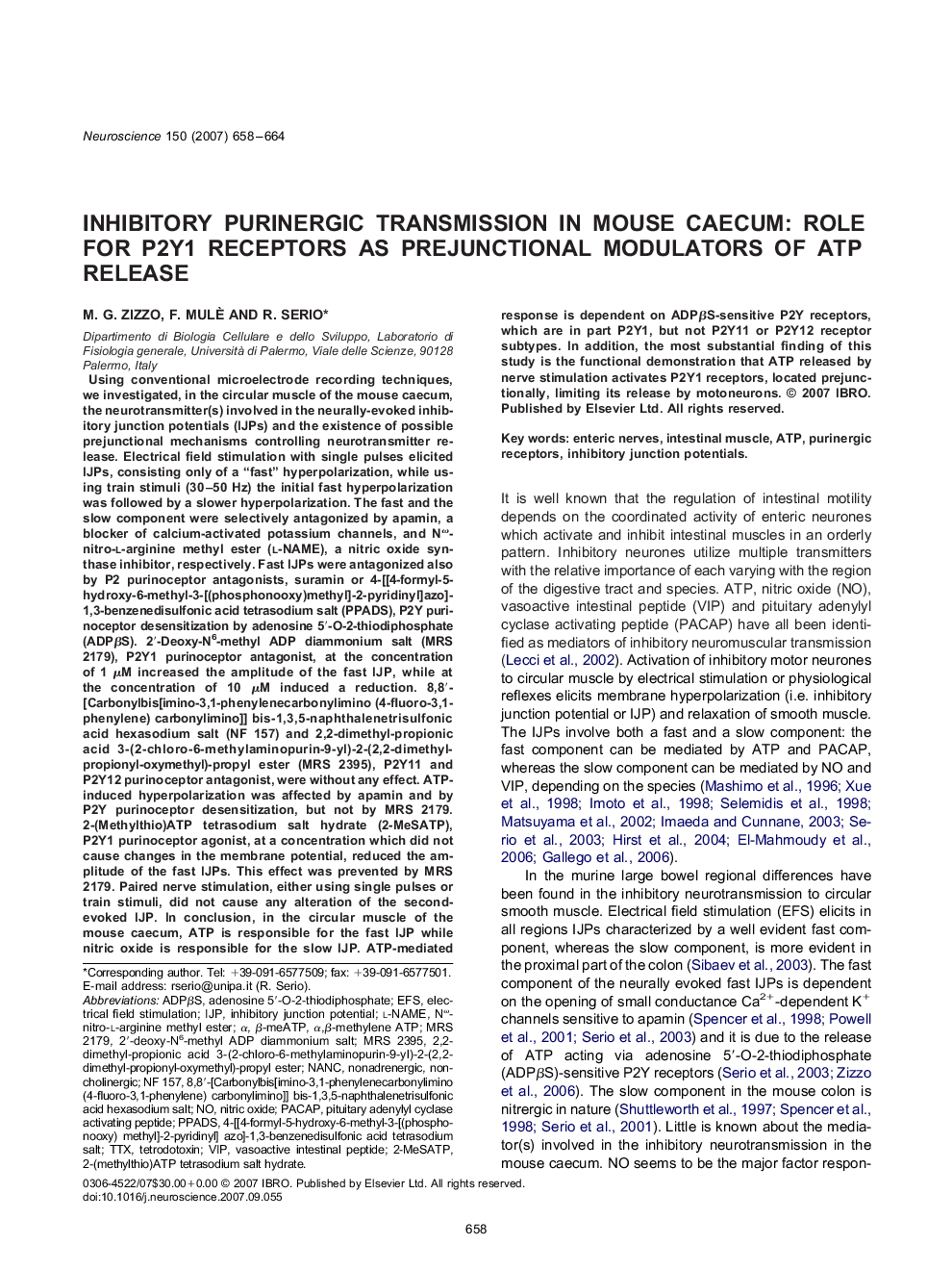| کد مقاله | کد نشریه | سال انتشار | مقاله انگلیسی | نسخه تمام متن |
|---|---|---|---|---|
| 4340954 | 1295817 | 2007 | 7 صفحه PDF | دانلود رایگان |
عنوان انگلیسی مقاله ISI
Inhibitory purinergic transmission in mouse caecum: Role for P2Y1 receptors as prejunctional modulators of ATP release
دانلود مقاله + سفارش ترجمه
دانلود مقاله ISI انگلیسی
رایگان برای ایرانیان
کلمات کلیدی
VIPEFsTTXIJPPACAP2-MeSATPPPADSNANCIntestinal muscleADPβSl-NAME - L-NAMENω-nitro-l-arginine methyl ester - N-Nitro-L-Arginine Methyl EsterATP - آدنوزین تری فسفات یا ATPEnteric nerves - اعصاب مجاری تنفسیtetrodotoxin - تترو دوتوکسین Electrical field stimulation - تحریک الکتریکی میدانnonadrenergic, noncholinergic - غیر آدرنرژیک، غیر کولینرژیکNitric oxide - نیتریک اکسیدinhibitory junction potential - پتانسیل اتصال مهار کنندهvasoactive intestinal peptide - پپتید روده روده ایPituitary adenylyl cyclase activating peptide - پپتید فعال آدنیلیل سیکلاز هپاتیتPurinergic receptors - گیرنده های Purinergic
موضوعات مرتبط
علوم زیستی و بیوفناوری
علم عصب شناسی
علوم اعصاب (عمومی)
پیش نمایش صفحه اول مقاله

چکیده انگلیسی
Using conventional microelectrode recording techniques, we investigated, in the circular muscle of the mouse caecum, the neurotransmitter(s) involved in the neurally-evoked inhibitory junction potentials (IJPs) and the existence of possible prejunctional mechanisms controlling neurotransmitter release. Electrical field stimulation with single pulses elicited IJPs, consisting only of a “fast” hyperpolarization, while using train stimuli (30-50 Hz) the initial fast hyperpolarization was followed by a slower hyperpolarization. The fast and the slow component were selectively antagonized by apamin, a blocker of calcium-activated potassium channels, and NÏ-nitro-l-arginine methyl ester (l-NAME), a nitric oxide synthase inhibitor, respectively. Fast IJPs were antagonized also by P2 purinoceptor antagonists, suramin or 4-[[4-formyl-5-hydroxy-6-methyl-3-[(phosphonooxy)methyl]-2-pyridinyl]azo]-1,3-benzenedisulfonic acid tetrasodium salt (PPADS), P2Y purinoceptor desensitization by adenosine 5â²-O-2-thiodiphosphate (ADPβS). 2â²-Deoxy-N6-methyl ADP diammonium salt (MRS 2179), P2Y1 purinoceptor antagonist, at the concentration of 1 μM increased the amplitude of the fast IJP, while at the concentration of 10 μM induced a reduction. 8,8â²-[Carbonylbis[imino-3,1-phenylenecarbonylimino (4-fluoro-3,1-phenylene) carbonylimino]] bis-1,3,5-naphthalenetrisulfonic acid hexasodium salt (NF 157) and 2,2-dimethyl-propionic acid 3-(2-chloro-6-methylaminopurin-9-yl)-2-(2,2-dimethyl-propionyl-oxymethyl)-propyl ester (MRS 2395), P2Y11 and P2Y12 purinoceptor antagonist, were without any effect. ATP-induced hyperpolarization was affected by apamin and by P2Y purinoceptor desensitization, but not by MRS 2179. 2-(Methylthio)ATP tetrasodium salt hydrate (2-MeSATP), P2Y1 purinoceptor agonist, at a concentration which did not cause changes in the membrane potential, reduced the amplitude of the fast IJPs. This effect was prevented by MRS 2179. Paired nerve stimulation, either using single pulses or train stimuli, did not cause any alteration of the second-evoked IJP. In conclusion, in the circular muscle of the mouse caecum, ATP is responsible for the fast IJP while nitric oxide is responsible for the slow IJP. ATP-mediated response is dependent on ADPβS-sensitive P2Y receptors, which are in part P2Y1, but not P2Y11 or P2Y12 receptor subtypes. In addition, the most substantial finding of this study is the functional demonstration that ATP released by nerve stimulation activates P2Y1 receptors, located prejunctionally, limiting its release by motoneurons.
ناشر
Database: Elsevier - ScienceDirect (ساینس دایرکت)
Journal: Neuroscience - Volume 150, Issue 3, 12 December 2007, Pages 658-664
Journal: Neuroscience - Volume 150, Issue 3, 12 December 2007, Pages 658-664
نویسندگان
M.G. Zizzo, F. Mulè, R. Serio,